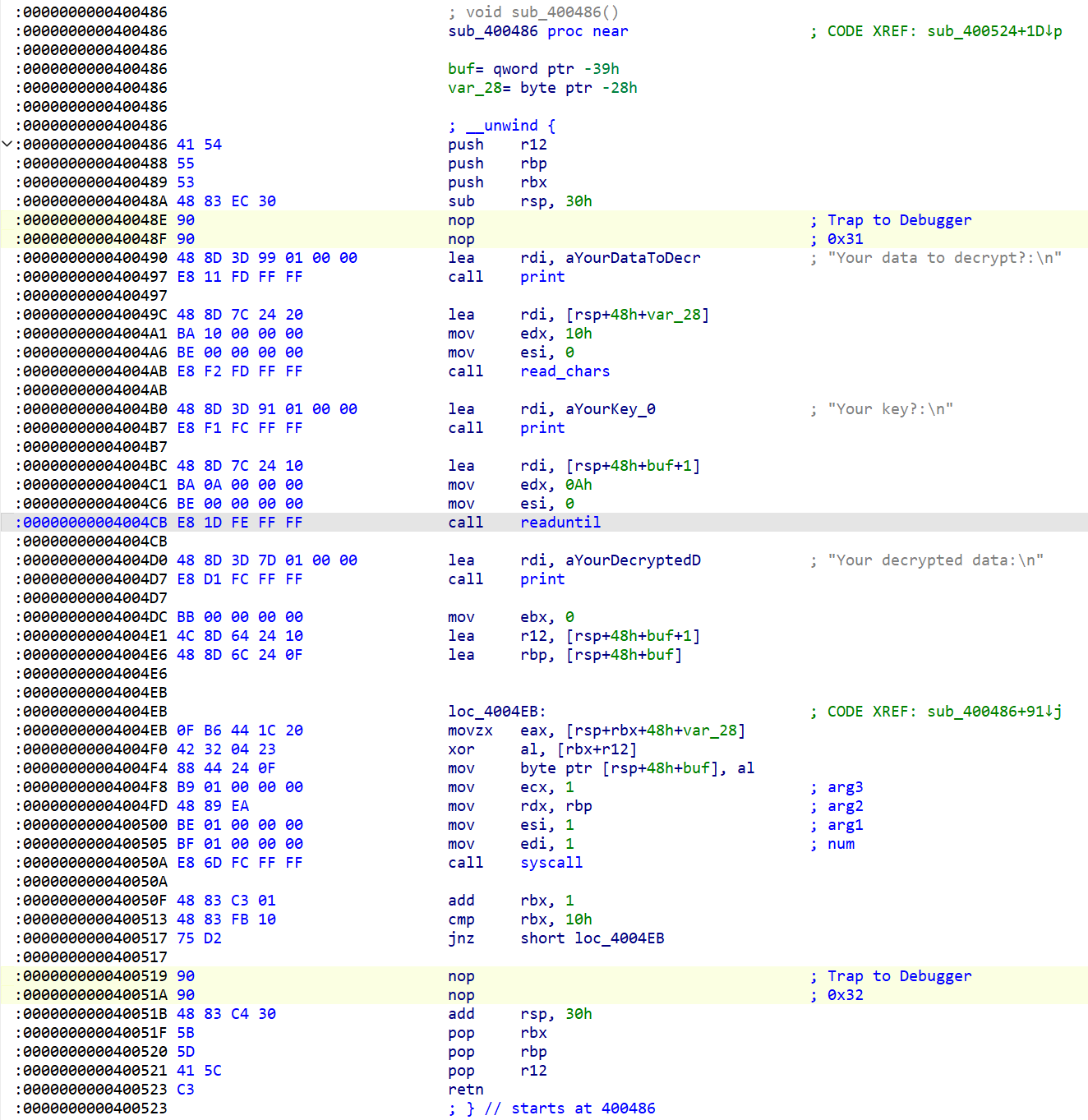1
2
3
4
5
6
7
8
9
10
11
12
13
14
15
16
17
18
19
20
21
22
23
24
25
26
27
28
29
30
31
32
33
34
35
36
37
38
39
40
41
42
43
44
45
46
47
48
49
50
51
52
53
54
55
56
57
58
59
60
61
62
63
64
65
66
67
68
69
70
71
72
73
74
75
76
77
78
79
80
81
82
83
84
85
86
87
88
89
90
91
92
93
94
95
96
97
98
99
100
101
102
103
104
105
106
107
108
109
110
111
112
113
114
115
116
117
118
119
120
121
122
123
124
125
126
127
128
129
130
131
132
133
134
135
136
137
138
139
140
141
142
143
144
145
146
147
148
149
150
151
152
153
154
155
156
157
158
159
160
161
162
163
164
165
166
167
168
169
170
171
172
173
174
175
176
177
178
179
180
181
182
183
184
185
186
187
188
189
190
191
192
193
194
195
196
197
198
|
import struct, random, string, subprocess, os, sys, hashlib
from collections import defaultdict
import resource
PTRACE_TRACEME = 0
PTRACE_PEEKTEXT = 1
PTRACE_PEEKDATA = 2
PTRACE_PEEKUSER = 3
PTRACE_POKETEXT = 4
PTRACE_POKEDATA = 5
PTRACE_POKEUSER = 6
PTRACE_CONT = 7
PTRACE_KILL = 8
PTRACE_SINGLESTEP = 9
PTRACE_GETREGS = 12
PTRACE_SETREGS = 13
PTRACE_GETFPREGS = 14
PTRACE_SETFPREGS = 15
PTRACE_ATTACH = 16
PTRACE_DETACH = 17
PTRACE_GETFPXREGS = 18
PTRACE_SETFPXREGS = 19
PTRACE_SYSCALL = 24
PTRACE_SETOPTIONS = 16896
PTRACE_GETEVENTMSG = 16897
PTRACE_GETSIGINFO = 16898
PTRACE_SETSIGINFO = 16899
PTRACE_LISTEN = 16904
PTRACE_O_TRACESYSGOOD = 1
PTRACE_O_TRACEFORK = 2
PTRACE_O_TRACEVFORK = 4
PTRACE_O_TRACECLONE = 8
PTRACE_O_TRACEEXEC = 16
PTRACE_O_TRACEVFORKDONE = 32
PTRACE_O_TRACEEXIT = 64
PTRACE_O_MASK = 127
PTRACE_O_TRACESECCOMP = 128
PTRACE_O_EXITKILL = 1048576
PTRACE_O_SUSPEND_SECCOMP = 2097152
PTRACE_SEIZE = 16902
import ctypes
from ctypes import *
from ctypes import get_errno, cdll
from ctypes.util import find_library
class user_regs_struct(Structure):
_fields_ = (
('r15', c_ulong),
('r14', c_ulong),
('r13', c_ulong),
('r12', c_ulong),
('rbp', c_ulong),
('rbx', c_ulong),
('r11', c_ulong),
('r10', c_ulong),
('r9', c_ulong),
('r8', c_ulong),
('rax', c_ulong),
('rcx', c_ulong),
('rdx', c_ulong),
('rsi', c_ulong),
('rdi', c_ulong),
('oax', c_ulong),
('rip', c_ulong),
('cs', c_ulong),
('eflags', c_ulong),
('rsp', c_ulong),
('ss', c_ulong),
('fs_base', c_ulong),
('gs_base', c_ulong),
('ds', c_ulong),
('es', c_ulong),
('fs', c_ulong),
('gs', c_ulong))
libc = CDLL('libc.so.6', use_errno=True)
ptrace = libc.ptrace
ptrace.argtypes = [c_uint, c_uint, c_long, c_long]
ptrace.restype = c_long
def mem_read(pid, pos=-1, tlen=8):
fd = os.open('/proc/%d/mem' % pid, os.O_RDONLY)
if pos >= 0:
os.lseek(fd, pos, 0)
buf = b''
while 1:
cd = os.read(fd, tlen - len(buf))
if cd == b'':
break
buf += cd
if len(buf) == tlen:
break
os.close(fd)
return buf
def pkiller():
from ctypes import cdll
import ctypes
cdll['libc.so.6'].prctl(1, 9)
def pnx(status):
def num_to_sig(num):
sigs = [
'SIGHUP', 'SIGINT', 'SIGQUIT', 'SIGILL', 'SIGTRAP', 'SIGABRT', 'SIGBUS', 'SIGFPE', 'SIGKILL', 'SIGUSR1', 'SIGSEGV', 'SIGUSR2', 'SIGPIPE', 'SIGALRM', 'SIGTERM', 'SIGSTKFLT', 'SIGCHLD', 'SIGCONT', 'SIGSTOP', 'SIGTSTP', 'SIGTTIN', 'SIGTTOU', 'SIGURG', 'SIGXCPU', 'SIGXFSZ', 'SIGVTALRM', 'SIGPROF', 'SIGWINCH', 'SIGIO', 'SIGPWR', 'SIGSYS']
if num - 1 < len(sigs):
return sigs[(num - 1)]
else:
return hex(num)[2:]
status_list = []
status_list.append(hex(status))
ff = [os.WCOREDUMP, os.WIFSTOPPED, os.WIFSIGNALED, os.WIFEXITED, os.WIFCONTINUED]
for f in ff:
if f(status):
status_list.append(f.__name__)
break
else:
status_list.append('')
status_list.append(num_to_sig(status >> 8 & 255))
ss = (status & 16711680) >> 16
ptrace_sigs = ['PTRACE_EVENT_FORK', 'PTRACE_EVENT_VFORK', 'PTRACE_EVENT_CLONE', 'PTRACE_EVENT_EXEC', 'PTRACE_EVENT_VFORK_DONE', 'PTRACE_EVENT_EXIT', 'PTRACE_EVENT_SECCOMP']
if ss >= 1:
if ss - 1 <= len(ptrace_sigs):
status_list.append(ptrace_sigs[(ss - 1)])
else:
status_list.append(hex(ss)[2:])
return status_list
def main():
pipe = subprocess.PIPE
fullargs = ['./s']
p = subprocess.Popen(fullargs, close_fds=True, preexec_fn=pkiller)
pid = p.pid
opid = pid
pid, status = os.waitpid(-1, 0)
ptrace(PTRACE_SETOPTIONS, pid, 0, PTRACE_O_TRACESECCOMP | PTRACE_O_EXITKILL | PTRACE_O_TRACECLONE | PTRACE_O_TRACEVFORK)
ptrace(PTRACE_CONT, pid, 0, 0)
SXX = set()
regs = user_regs_struct()
while True:
pid, status = os.waitpid(-1, 0)
ssy = pnx(status)
if ssy[1] == 'WIFEXITED':
break
if ssy[2] == 'SIGSEGV':
break
if ssy[2] == 'SIGTRAP':
res = ptrace(PTRACE_GETREGS, pid, 0, ctypes.addressof(regs))
nn = mem_read(pid, regs.rip, 1)[0]
if nn == 0x48:
regs.rax = regs.rdi
regs.rdi = regs.rsi
ptrace(PTRACE_SETREGS, pid, 0, ctypes.addressof(regs))
else:
if nn == 0x11 or nn == 0x21 or nn == 0x31:
offd = {17:0, 33:40, 49:72}
vv = mem_read(pid, regs.rsp + offd[nn], 8)
vv = struct.unpack('<Q', vv)[0]
SXX.add(vv)
regs.rip += 1
ptrace(PTRACE_SETREGS, pid, 0, ctypes.addressof(regs))
elif nn == 0x12 or nn == 0x22 or nn == 0x32:
offd = {18:0, 34:40, 50:72}
vv = mem_read(pid, regs.rsp + offd[nn], 8)
vv = struct.unpack('<Q', vv)[0]
if vv not in SXX:
print('\n\n!!!Stack Violation Detected!!!\n\n')
regs.rip = 0
ptrace(PTRACE_SETREGS, pid, 0, ctypes.addressof(regs))
break
SXX.remove(vv)
regs.rip += 1
ptrace(PTRACE_SETREGS, pid, 0, ctypes.addressof(regs))
res = ptrace(PTRACE_CONT, pid, 0, 0)
try:
p.kill()
except OSError:
pass
while 1:
try:
pid, status = os.waitpid(-1, 0)
ssy = pnx(status)
except ChildProcessError:
break
if __name__ == '__main__':
sys.exit(main())
|

